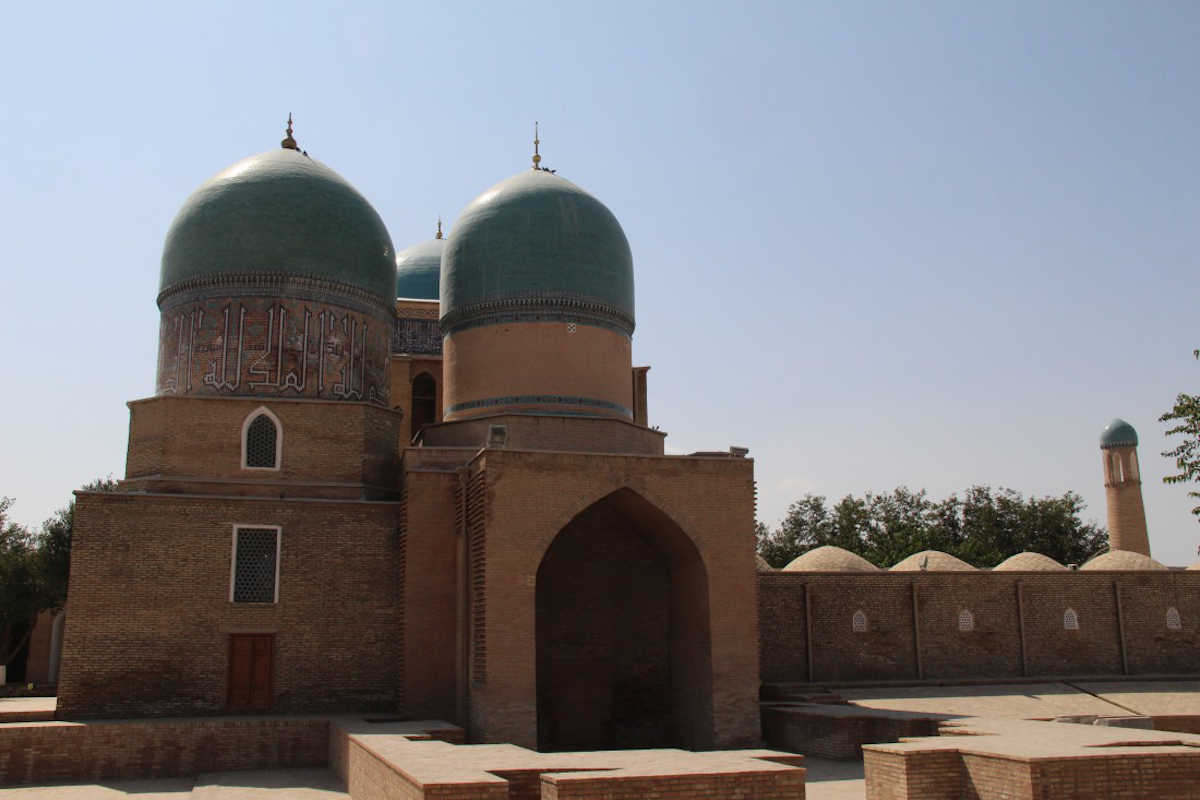Shakhrisabz - Mausoleum Gumbazi Sayidon

The Gumbazi Sayidon Mausoleum in Shakhrisabz – a masterpiece of Timurid architecture
On the south side of the mausoleum of Shamsiddin Kulol in Shakhrisabz is another important building: the Gumbazi Sayidon Mausoleum. This magnificent mausoleum, whose name means ‘The Dome of the Sayids’, was probably built as a resting place for descendants of Ulugbek and is part of the important Dorut-Tilovat ensemble. Immediately south of the mausoleum of Shamsiddin Kulol, Mirzo Ulugbek had this imposing domed mausoleum built, which served as a burial place for members of the Temurid dynasty and is known as the ‘Maqbara of Ulugbek’.
Architecture and design
The Gumbazi Sayidon impresses with its balanced proportions and its masterfully designed entrance door, which is decorated with deep, three-dimensional carvings of floral and epigraphic ornaments. Stylistically and historically, the entire architectural ensemble belongs to Ulugbek’s era. Two years after the construction of the Kok Gumbaz mosque in Shakhrisabz, Ulugbek gave the order to build another tomb on the south wall of the mausoleum of Shamsiddin Kulol. This mausoleum completed the Dorut-Tilovat ensemble and emphasises the architectural mastery of the Temurid dynasty.
The mausoleum is an almost square building with a small, slightly protruding portal on the west side. The skilfully carved wooden door is decorated with deep, triangular ornamentation featuring both vegetative and epigraphic motifs. The lower section of the main hall is decorated with ornate panels of blue hexagonal tiles. Particularly noteworthy are the paintings in shades of red and blue that adorn the dome sails, arched niches and wall surfaces, reflecting exceptional artistic mastery.
The blue dome rises on a high drum, which is decorated with ornate Kufi inscriptions in mosaic technique. The ornamental belt beneath the dome is filled with complex geometric patterns that form a star-shaped motif. The dome itself is decorated with the highly complex polyhedral girikh, an interlaced ornamental structure typical of Timurid architecture. Filigree floral patterns adorn the arches, while spiral-shaped ornaments decorate the wall surfaces. Diffuse light enters the interior through artistically designed window openings in the drum, giving the dome a floating, almost mystical appearance.
Historical significance and inscriptions
There is an impressive inscription in Arabic calligraphy on the portal of the mausoleum, which emphasises the importance of the building:
‘The great, honourable and generous Sultan Ulugbek Guragan, dignitary of the Sultans, lord and defender of the people and the faith, ordered the construction of the Mausoleum-Makbarat, called ‘Awlad al-Mubarak’ (‘Blessed Progeny’). May Allah immortalise his rule and power, in the month of the moon of the year 841 Hijrah (1437).’
For a long time, historians disagreed about the identity of the people buried there. While it was initially assumed that Ulugbek built the mausoleum for his descendants, there is no evidence on any of the tombstones that members of the Temurid dynasty were buried there. Instead, the marble tombstones in the mausoleum date from the 10th to 17th centuries. Four of them were attributed to historically important members of the Sayid family from Termez. The Sayids played a prominent role in supporting Amir Temur in his battles against the Mongol khans, particularly in the second half of the 14th century.
One of the most important personalities of this family was Abu al-Mu’ali, whose tombstone can be found among the tombs in the Gumbazi Sayidon. He was instrumental in the military conflicts with the Mongols and took part in Temur’s accession to the throne.
Extensions and changes over the centuries
There are numerous other tombs around the mausoleum. The well-preserved marble tombstones from the 15th to 17th centuries bear the names of prominent members of the Sayids of Termez, which later led to the memorial being named ‘Gumbazi Sayidon’.
In the 17th century, the Khonaqo Arslan-Khan, an important building for spiritual gatherings and Sufi practices, was added to the east side of the Shamsiddin Kulol mausoleum, but was demolished in 1954. In the meantime, the entrances to the mausoleums were redesigned so that access to the Gumbazi Sayidon was now through the Khonaqo and the Sheikh’s mausoleum.
An important testimony to Timurid architecture
This ensemble of mausoleums, madrasahs and spiritual sites is one of the most important architectural and historical testimonies of the Timurid era and illustrates the highly developed craftsmanship as well as the deep religious and philosophical thinking of this time. The elaborate ornamentation, calligraphic inscriptions and architectural innovations in the Gumbazi Sayidon Mausoleum are not only an outstanding example of Timurid architecture, but also an important symbol of the spiritual and cultural flourishing of the Islamic world in the 15th century.
